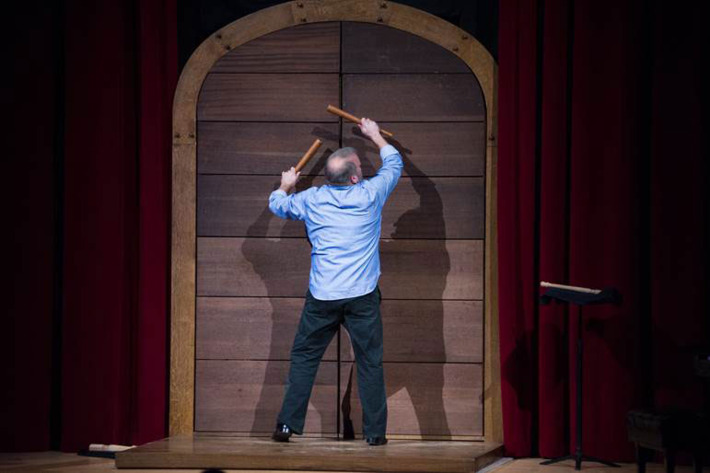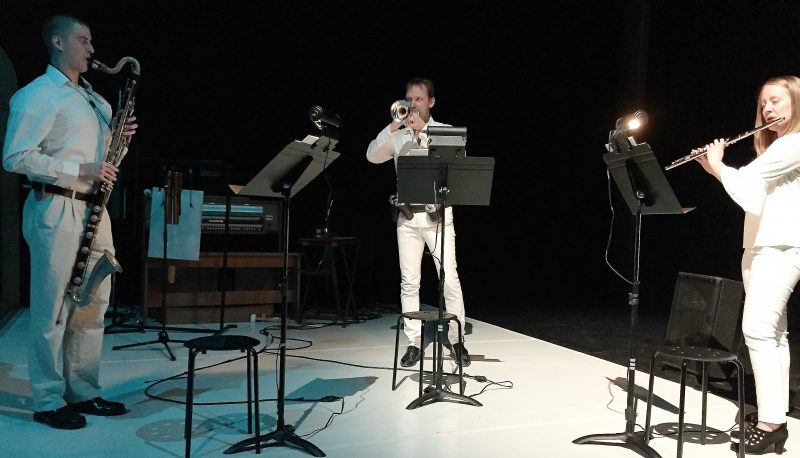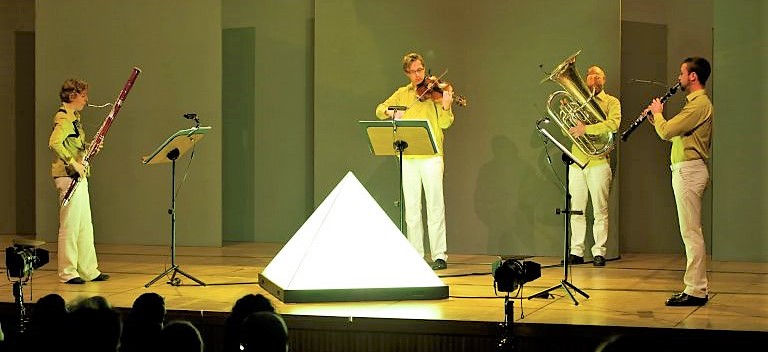
Klang by Karlheinz Stockhausen. Philadelphia Fringe Festival, April 7 & 8, 2018.
Karlheinz Stockhausen is a controversial but important figure in modern music. Many observers are wary of Stockhausen because of his fantastic belief that we live in a universe named Nebadon on a planet named Urantia, and because he seemed obsessed with religiosity. His music for the massive Klang is accompanied by a recorded voice which repeats religious incantations in German.
Yet I’ve been able to tune out those aspects and concentrate on the rest of his sounds. A two-day exploration of this composition in Philadelphia was a superb presentation.
Elizabeth Huston and Joseph Drew deserve immense credit for this adventure. He was in charge of the music and she for the producing and fund-raising. Neither Huston nor Drew was specifically a cheerleader for the composer. Their approach was not as worshipers but as investigators. Each of them became attracted because of his massive output which is rarely performed, and because he created such a challenging, complex, multi-part work.
Huston is a harpist who produced Luciano Berio’s virtuosic instrumental Sequenzas at the 2014 Philadelphia Fringe Festival. Drew is a trumpeter who studied with Stockhausen in Germany prior to the composer’s death in 2008 at the age of 79. Klang was his last composition. The translation of the full title is “Sound: The 24-hours of the Day” and Stockhausen died after completing the 21st “hour.” (The music “represents” each hour of the day but does not actually run that long.)
They employed mostly Philadelphia performers, and Drew coached them over a period of months. The production also used members of MusikFabrik from Cologne and individual instrumentalists for whom Stockhausen composed some of his pieces.
Stockhausen’s intent was to chart a soul’s journey from the body into the afterlife. You could listen and reflect on time, spirituality, and the meaning of mortality. Or you could reject all that and still be impressed by Stockhausen’s stretching the limits of instruments capabilities. The composition includes sections for solo instruments, for voices, and for combinations. Some parts are acoustic, some electronic, and some are a blend of synthesizers, voices and instruments.
Stockhausen emerged in the 1950s as an innovative composer of avant-guard music, especially electronic. The Beatles included his face on the cover of Sgt. Pepper’s Lonely Hearts Club Band. Some of his scores are written so that the performance can start on any page, and may be read upside down, or from right to left as the performer chooses. Such strange things, plus his religious fervor, cause some music lovers to label him a nut case. Even if he was, however, the music is intriguing.
Because Klang is the culmination of his life’s work, many attendees approached this concert with awe, while others came out of curiosity, and there was much to satisfy both sides.
The music for each instrument pushed limits of range, rhythms and harmonies. You don’t often see showpieces for basset horn, or French horn, or bass clarinet (which looks like a very long saxophone), but you did here. Brass players made extensive changes of mutes. During some instrumental trios the players rotated their positions in relation to each other, and even circled in place. Stockhausen specified this choreography, saying that the universe is spinning and circling, and also pointing out that music changes as it arrives in our ears from different directions.
One section is called “Heaven’s Door” and consists of a percussionist beating on a door. Stockhausen composed it for Stuart Gerber, who performed it here. A door, eight feet tall, has twelve individual panels of oak, poplar, walnut, cherry, mahogany and other woods. Each panel produces a unique, marimba-like tone. The door was manufactured to Stockhausen’s specs and is housed at Georgia State University in Atlanta, where Gerber teaches. Near the end of the piece, the percussionist opens the door and walks through it, followed by a silent young girl, apparently signifying that anyone is free to enter the doorway to eternal life.
Other standout soloists were the trumpet players Joe Drew and Marco Blaauw and oboist Geoffrey Deemer, whom we also heard this month in the AVA production of La Traviata — among many other talented performers. One of the intriguing musical aspects is that all of Stockhausen’s trios ended with a major chord, which is odd for a writer of modernistic serialism and aleatory music. Was he, perhaps, having a vision of a hereafter where everything ends harmoniously?
Huston and Drew brought in to the Fringe auditorium elaborate equipment which included eight speakers hanging near the ceiling, two on each side of the room, and four huge sub-woofers in four-foot-wide cabinets in the corners of the room. This produced rich multi-dimensional sound which moved around the listener and zoomed across the ceiling, under the control of a console in the center of the auditorium.
Stockhausen assigned each of the parts of Klang a specific color which was projected by designer Thomas Dunn. Adrienne Mackey coached the performers in their movements. Seating was flexible with audience members allowed to lay on the floor alongside the players. Those who needed a break could come and go, or attend ongoing lectures by performers and Stockhausen experts.
Incidentally, the controversy about Stockhausen apparently caused media to avoid this event, even though this should have heightened their interest. I didn’t see a review in any newspaper or any other web publication.
To see & hear Stockhausen, courtesy of Arts Council England, click here.
Below, Klang trio, and quartet photo by Klaus Rudolph:

